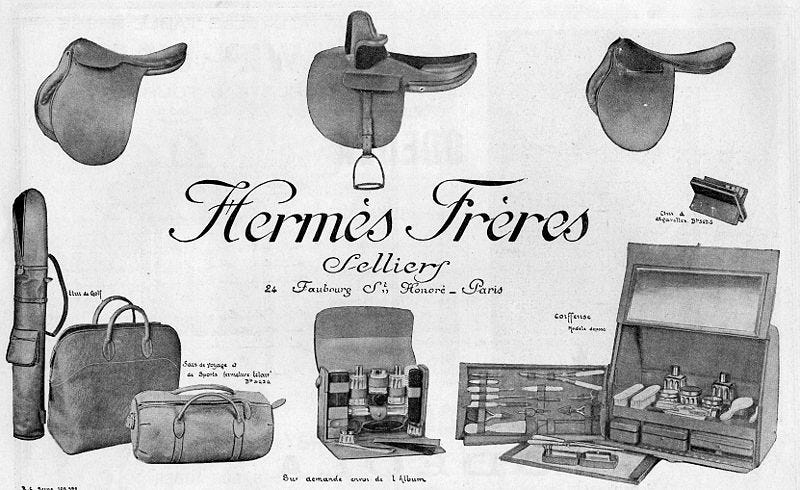Brand DNA and Brand Story; Hermes' Equestrian Heritage.
The brand story should communicate elements of the Brand DNA.
Let's chop it up,
Communicating a brand boils down to one action: communicating your brand's DNA through your brand's story. Long-lasting brands are married to their DNA and consistent with their story. As a result, they attract people who mirror their principles and build a fervent community.
BRAND DNA
It starts with its Brand DNA—the essence that drives everything it does. Brand DNA refers to the core essence and fundamental characteristics that make a brand unique. It encompasses:
Values: These core beliefs guide the brand's actions and decisions. Values shape how a brand interacts with its audience, partners, and employees. They represent what the brand stands for and create the moral compass for the business.
Mission: This is the brand's reason for existing—the "why" behind everything it does. It answers the question: What problem are we solving, and why are we solving it? The mission is typically action-oriented, driving the brand's day-to-day efforts and long-term goals. A clear mission statement helps everyone understand the brand's purpose and keeps the company aligned.
Vision: While the mission focuses on the present, the vision is all about the future. It outlines the brand's aspirations and where it sees itself in the long term. The vision provides inspiration and direction internally for the team and externally for stakeholders. It's the big-picture goal that the brand is working towards.
Personality: This defines how the brand expresses itself and how its audience perceives it. Just like a person, a brand's personality can be friendly, professional, quirky, or authoritative, depending on how it wants to connect with people. Personality is reflected in the tone of voice, the imagery used, and the customer's overall experience with the brand. It's what makes a brand relatable and memorable.
Key Differentiators: These unique characteristics set the brand apart from its competitors. They could be anything from superior product quality, innovative features, exceptional customer service, or even a distinct brand voice. Differentiators make the brand stand out in a crowded marketplace and give customers a compelling reason to choose it over others.
Think of brand DNA as the genetic makeup of a brand. These intrinsic qualities remain consistent and guide all brand decisions and actions.
Take Hermès. Their DNA seems rooted in artisan craftsmanship, exclusivity, and timeless luxury. They are deeply committed to meticulous, handcrafted products and an uncompromising quality standard.
Hermès began in 1837 as a harness and saddle maker, serving the equestrian elite. Over time, it evolved into a global symbol of luxury. Still, its DNA remained the same at its core—an unwavering focus on excellence, craftsmanship, and heritage.
Brand Story
But what makes Hermès special is how it tells this story, right? Brand Story takes the DNA and brings it to life. A brand story is the narrative that brings the brand's DNA to life. It weaves together the various elements of the brand DNA into a compelling and relatable tale that resonates with the target audience. A good brand story typically includes:
Origin or founding story
Challenges to overcome
Company's purpose and impact
Customer benefits and experiences
Hermès' story is about its equestrian heritage, which is woven into everything. Its iconic products, from leather bags to silk scarves, echo this history of precision and artistry.


You can even find this heritage influence in its pet products, with cavaletti doghouses and bit-shaped chew toys.
From sponsoring equestrian competitions to featuring horses in their marketing campaigns, Hermès uses its story to create an emotional connection with its audience.
This story resonates with customers because it's authentic. That's the beauty of grounding your work in your brand's DNA as you visually reinforce it through every product and touchpoint.
The point is that brand DNA and brand story work together seamlessly. Brand DNA provides the foundation—your core values, your mission, what you stand for—while the story is how that gets communicated to the world.
The DNA is the structure; the story is its voice. For a brand to stay authentic, the story must align with and reinforce the DNA, ensuring that every message, campaign, and customer interaction reflects consistency. Through this alignment, a brand creates an emotional connection with its audience—the DNA defines who you are, and the story makes people care. Both guide the business at every level, from product development to marketing strategies, ensuring every decision is rooted in the brand's core.
As the brand grows and evolves, the DNA stays constant, but the story can adapt, reflecting those changes while staying true to what's at the heart of the brand. For Hermès, the tale of equestrian heritage and timeless luxury perfectly reflects its DNA, making the brand unforgettable.









